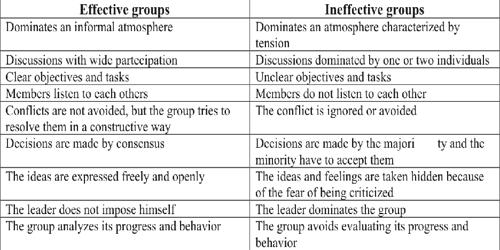Ineffective group communication is poor team communication from lack of trust, respect, commitment, and cooperation. A group structure is used in the workplace to coordinate projects and provide expertise from multiple viewpoints. Difference between effective groups and ineffective groups:
Effective Groups
- Independence is used in a positive way, so that goal is achieved by the group that otherwise would not be achievable.
- The Task of the objective of the group is well understood and accepted by the members.
- Goals are clarified and modified so that the best possible match between individual goals and the group’s goals is achieved, goals are structured cooperatively so all members are committed to achieving them.
- Communication is two-way, and the open and accurate expression of both ideas and feelings is emphasized.
- The chairperson of the group does not dominate it, nor does the group refer unduly to him or her.
- There is a lot of discussions in which virtually everyone participates, but it remains pertinent to the task of the group.
- The members listen to each other. Every idea is given a hearing. Most decisions are reached by a form of consensus in which it is clear that everybody is in general agreement.
- In Conflict Resolution, there is disagreement. The group is comfortable with this and shows no signs of having to avoid conflict.
- The group is conscious of its own operations. Frequently, it will stop to examine how well it is doing, or what may be interfering with its operation.
Ineffective Groups
- Interdependence is not used Conductivity; the group does not achieve its goals easily or effectively.
- From the things which are said, it is difficult to understand what the group task is, or what its objectives are.
- Members accept imposed games; goals are competitively ruptured so that each member strives to outperform the others.
- Communication is one-way and only ideas are expressed; feelings are suppressed or ignored.
- Leadership remains clear with the group chairperson. He or she may be weak or strong but always sits ‘at the head of the table’.
- A few people tend to dominate the discussion. Often their contributions are way off the point.
- People do not really listen to each other. Ideas are ignored and over-ridden. Actions are taken prematurely before the real issues are either examined or resolved.
- Disagreements are generally not dealt with effectively by the group. They may be suppressed by the leader, resulting in open warfare, or resolved by a vote in which the minority is barely smaller than the majority.
- The group tends to avoid any discussion of its own maintenance.
















